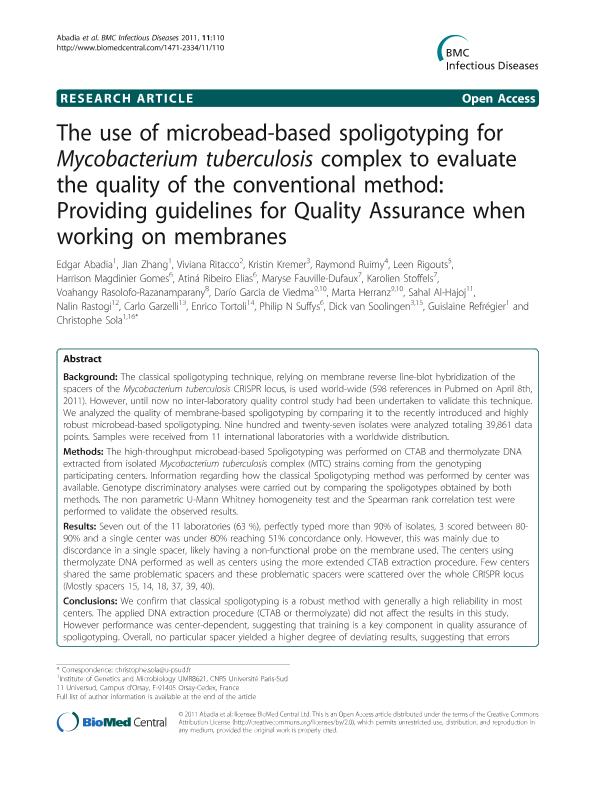Mostrar el registro sencillo del ítem
dc.contributor.author
Abadia, Edgar
dc.contributor.author
Zhang, Jian
dc.contributor.author
Ritacco, Gloria Viviana

dc.contributor.author
Kremer, Kristin
dc.contributor.author
Ruimy, Raymond
dc.contributor.author
Rigouts, Leen
dc.contributor.author
Gomes, Harrison M.
dc.contributor.author
Elias, Atiná R.
dc.contributor.author
Fauville-Dufaux, Maryse
dc.contributor.author
Stoffels, Karolien
dc.contributor.author
Rasolofo Razanamparany, Voahangy
dc.contributor.author
de Viedma, Darío G.
dc.contributor.author
Herranz, Marta
dc.contributor.author
Al-Hajoj, Sahal
dc.contributor.author
Rastogi, Nalin
dc.contributor.author
Garzelli, Carlo
dc.contributor.author
Tortoli, Enrico
dc.contributor.author
Suffys, Philip Noel

dc.contributor.author
van Soolingen, Dick
dc.contributor.author
Refrégier, Guislaine
dc.contributor.author
Sola, Christophe
dc.date.available
2023-02-23T18:02:36Z
dc.date.issued
2011-04
dc.identifier.citation
Abadia, Edgar; Zhang, Jian; Ritacco, Gloria Viviana; Kremer, Kristin; Ruimy, Raymond; et al.; The use of microbead-based spoligotyping for Mycobacterium tuberculosis complex to evaluate the quality of the conventional method: Providing guidelines for Quality Assurance when working on membranes; BioMed Central; BMC Infectious Diseases; 11; 4-2011; 1-8
dc.identifier.issn
1471-2334
dc.identifier.uri
http://hdl.handle.net/11336/188752
dc.description.abstract
Background: The classical spoligotyping technique, relying on membrane reverse line-blot hybridization of the spacers of the Mycobacterium tuberculosis CRISPR locus, is used world-wide (598 references in Pubmed on April 8th, 2011). However, until now no inter-laboratory quality control study had been undertaken to validate this technique. We analyzed the quality of membrane-based spoligotyping by comparing it to the recently introduced and highly robust microbead-based spoligotyping. Nine hundred and twenty-seven isolates were analyzed totaling 39,861 data points. Samples were received from 11 international laboratories with a worldwide distribution.Methods: The high-throughput microbead-based Spoligotyping was performed on CTAB and thermolyzate DNA extracted from isolated Mycobacterium tuberculosis complex (MTC) strains coming from the genotyping participating centers. Information regarding how the classical Spoligotyping method was performed by center was available. Genotype discriminatory analyses were carried out by comparing the spoligotypes obtained by both methods. The non parametric U-Mann Whitney homogeneity test and the Spearman rank correlation test were performed to validate the observed results.Results: Seven out of the 11 laboratories (63 %), perfectly typed more than 90% of isolates, 3 scored between 80-90% and a single center was under 80% reaching 51% concordance only. However, this was mainly due to discordance in a single spacer, likely having a non-functional probe on the membrane used. The centers using thermolyzate DNA performed as well as centers using the more extended CTAB extraction procedure. Few centers shared the same problematic spacers and these problematic spacers were scattered over the whole CRISPR locus (Mostly spacers 15, 14, 18, 37, 39, 40).Conclusions: We confirm that classical spoligotyping is a robust method with generally a high reliability in most centers. The applied DNA extraction procedure (CTAB or thermolyzate) did not affect the results in this study. However performance was center-dependent, suggesting that training is a key component in quality assurance of spoligotyping. Overall, no particular spacer yielded a higher degree of deviating results, suggesting that errors occur randomly either in the process of re-using membranes, or during the reading of the results and transferring of data from the film to a digital file. Last, the performance of the microbead-based method was excellent as previously shown by Cowan et al. (J. Clin. Microbiol. 2004) and Zhang et al. (J. Med. Microbiol. 2009) and demonstrated the proper detection of spacer 15 that is known to occasionally give weak signals in the classical spoligotyping.
dc.format
application/pdf
dc.language.iso
eng
dc.publisher
BioMed Central

dc.rights
info:eu-repo/semantics/openAccess
dc.rights.uri
https://creativecommons.org/licenses/by/2.5/ar/
dc.subject
SPOLIGTYPING
dc.subject
MYCOBACTERIUM TUBERCULOSIS
dc.subject
CRISP LOCUS
dc.subject
MICROBEADS
dc.subject.classification
Biología Celular, Microbiología

dc.subject.classification
Ciencias Biológicas

dc.subject.classification
CIENCIAS NATURALES Y EXACTAS

dc.subject.classification
Enfermedades Infecciosas

dc.subject.classification
Ciencias de la Salud

dc.subject.classification
CIENCIAS MÉDICAS Y DE LA SALUD

dc.subject.classification
Tecnologías que involucran la identificación de ADN, proteínas y enzimas, y cómo influyen en el conjunto de enfermedades y mantenimiento del bienestar

dc.subject.classification
Biotecnología de la Salud

dc.subject.classification
CIENCIAS MÉDICAS Y DE LA SALUD

dc.title
The use of microbead-based spoligotyping for Mycobacterium tuberculosis complex to evaluate the quality of the conventional method: Providing guidelines for Quality Assurance when working on membranes
dc.type
info:eu-repo/semantics/article
dc.type
info:ar-repo/semantics/artículo
dc.type
info:eu-repo/semantics/publishedVersion
dc.date.updated
2023-02-21T22:17:46Z
dc.journal.volume
11
dc.journal.pagination
1-8
dc.journal.pais
Reino Unido

dc.journal.ciudad
Londres
dc.description.fil
Fil: Abadia, Edgar. Université de Paris XI; Francia
dc.description.fil
Fil: Zhang, Jian. Université de Paris XI; Francia
dc.description.fil
Fil: Ritacco, Gloria Viviana. Dirección Nacional de Institutos de Investigación. Administración Nacional de Laboratorios e Institutos de Salud. Instituto Nacional de Enfermedades Infecciosas; Argentina. Consejo Nacional de Investigaciones Científicas y Técnicas; Argentina
dc.description.fil
Fil: Kremer, Kristin. National Institute Of Public Health And The Environment; Países Bajos
dc.description.fil
Fil: Ruimy, Raymond. Université Paris Diderot - Paris 7; Francia
dc.description.fil
Fil: Rigouts, Leen. Institute Of Tropical Medicine; Bélgica
dc.description.fil
Fil: Gomes, Harrison M.. Instituto Oswaldo Cruz; Brasil
dc.description.fil
Fil: Elias, Atiná R.. Instituto Oswaldo Cruz; Brasil
dc.description.fil
Fil: Fauville-Dufaux, Maryse. Scientific Institute Of Public Health; Bélgica
dc.description.fil
Fil: Stoffels, Karolien. Scientific Institute Of Public Health; Bélgica
dc.description.fil
Fil: Rasolofo Razanamparany, Voahangy. Institut Pasteur de Madagascar; Madagascar
dc.description.fil
Fil: de Viedma, Darío G.. Hospital General Universitario Gregorio Marañon; España
dc.description.fil
Fil: Herranz, Marta. Hospital General Universitario Gregorio Marañon; España
dc.description.fil
Fil: Al-Hajoj, Sahal. King Faisal Specialist Hospital And Research Center; Arabia Saudita
dc.description.fil
Fil: Rastogi, Nalin. Instituto Pasteur; Francia
dc.description.fil
Fil: Garzelli, Carlo. Università Di Pisa; Italia
dc.description.fil
Fil: Tortoli, Enrico. Careggi Hospital; Italia
dc.description.fil
Fil: Suffys, Philip Noel. Instituto Oswaldo Cruz; Brasil
dc.description.fil
Fil: van Soolingen, Dick. National Institute Of Public Health And The Environment; Países Bajos
dc.description.fil
Fil: Refrégier, Guislaine. Université de Paris XI; Francia
dc.description.fil
Fil: Sola, Christophe. Université de Paris XI; Francia
dc.journal.title
BMC Infectious Diseases

dc.relation.alternativeid
info:eu-repo/semantics/altIdentifier/url/http://www.biomedcentral.com/1471-2334/11/110
dc.relation.alternativeid
info:eu-repo/semantics/altIdentifier/doi/http://dx.doi.org/10.1186/1471-2334-11-110
Archivos asociados
